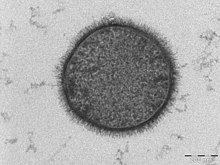Our website is made possible by displaying online advertisements to our visitors.
Please consider supporting us by disabling your ad blocker.
Ultrastructure
This article's factual accuracy is disputed. (May 2017) |

Ultrastructure (or ultra-structure) is the architecture of cells and biomaterials that is visible at higher magnifications than found on a standard optical light microscope. This traditionally meant the resolution and magnification range of a conventional transmission electron microscope (TEM) when viewing biological specimens such as cells, tissue, or organs. Ultrastructure can also be viewed with scanning electron microscopy and super-resolution microscopy, although TEM is a standard histology technique for viewing ultrastructure. Such cellular structures as organelles, which allow the cell to function properly within its specified environment, can be examined at the ultrastructural level.
Ultrastructure, along with molecular phylogeny, is a reliable phylogenetic way of classifying organisms.[1] Features of ultrastructure are used industrially to control material properties and promote biocompatibility.
- ^ Laura Wegener Parfrey; Erika Barbero; Elyse Lasser; Micah Dunthorn; Debashish Bhattacharya; David J Patterson; Laura A Katz (December 2006). "Evaluating support for the current classification of eukaryotic diversity". PLOS Genetics. 2 (12): e220. doi:10.1371/JOURNAL.PGEN.0020220. ISSN 1553-7390. PMC 1713255. PMID 17194223. Wikidata Q21090155.
Previous Page Next Page


